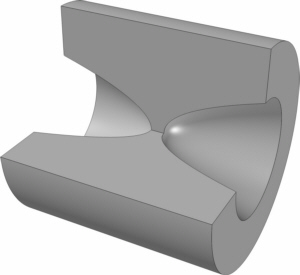The group of Prof. B. Lengeler (RWTH Aachen) developed CRLs produced by embossing needles with parabolic shaped tips in several hundred micro meter thick aluminium or beryllium foils (fig. 1). Many of these focusing elements are precisely aligned in a row to form a CRL (fig. 2). One advantages of this method is the rotational symmetric geometry of the lens elements providing a qualitatively good point focus. Another advantage is, that the lenses can stand very high X-ray intensities. The effort to align the elements and the limited minimum radius of curvature (due to the mechanical stability of the needles) can be seen as disadvantages.

Fig. 1: Single focusing element of a CRL made by embossing

Fig. 2: CRL formed by arranging many lens elements in a row
| [Len 1999] | B. Lengeler, C. Schroer, J. Tümmler, B. Benner, M. Richwin, A. Snigirev, I. Snigireva, and M. Drakopoulos, Imaging by parabolic refractive lenses in the hard X-ray range, J. Synchrotron Rad. vol. 6, pp. 1153-1167, DOI:10.1107/S0909049599009747, 1999 |


